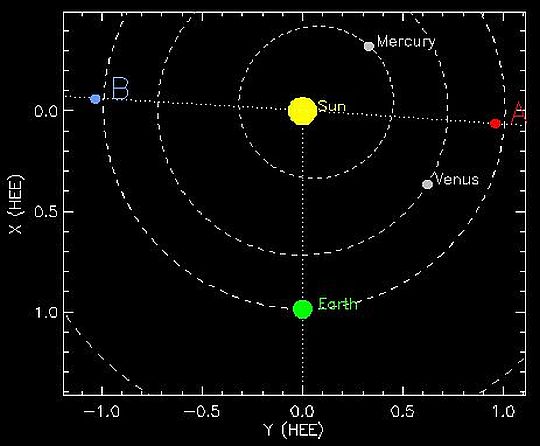APOD has a spectacular video of a comet impacting the Sun followed by a coronal mass ejection.
Astronomy
A Secondary Consequence of Solar Minima
I browsed through my copy of QST magazine yesterday. QST is the publication of the American Radio Relay League, an amateur radio (ham radio) organization. In it, I read an interesting scientific hypothesis explaining the dearth of sunspots we have seen over the past several years. The theory holds that plasma currents deep inside the sun may have interfered with the formation of sunspots and prolonged the solar minimum.
Later in the article, there is mention of a secondary consequence of the minimum in that “space junk” can remain in low Earth orbit due to the upper atmosphere collapsing. You can read this very interesting article at this link.
NASA-sponsored research has resulted in the first computer model that explains the recent period of decreased solar activity during the sun’s 11-year cycle.
This recent solar minimum, a period characterized by a lower frequency of sunspots and solar storms, was the deepest observed in almost 100 years. The solar minimum has repercussions on the safety of space travel and the amount of orbital debris our planet accumulates.
. . .
During this deep solar minimum, the sun’s magnetic field weakened, allowing cosmic rays to penetrate the solar system in record numbers, making space a more dangerous place to travel. At the same time, the decrease in ultraviolet radiation caused Earth’s upper atmosphere to cool and collapse.
As a consequence space debris stopped decaying and started accumulating in Earth orbit due to decreased atmospheric drag. These effects demonstrate the importance of understanding the entire solar cycle, during both minimum and maximum.
Emphasis added.
Solar Activity Then and Now
Old Sol continues to increase in activity, moving toward the eleven-year peak. Solar activity affects climate, auroras, (possibly) the electric power grid and radio propagation. For an impressive animation of this comparison, play the video below. To view the full-sized video, click here.
From SOHO Pick of the Week:
A side-by-side comparison of the Sun from precisely two years ago (left, from SOHO) to the present (right, from Solar Dynamics Observatory) dramatically illustrates just how active the Sun has become (Mar. 27-28, 2011). Viewed in two similar wavelengths of extreme ultraviolet light, the Sun now sports numerous active regions that appear as lighter areas that are capable of producing solar storms. Two years ago the Sun was in a very quiet period (solar minimum). The Sun?s maximum period of activity is predicted to be around 2013, so we still have quite a ways to go.
Perigee Moon
Maybe if the cloud cover burns off here this evening, we will be able to see the perigee full moon. I looked at the weather maps for here and the old house in California and it appears that we may not get to see much of it, if any. We did see it big and bright last night when it was at 92% of full, though. It sure was pretty.
We are planning to depart tomorrow morning for the old house. We have some business there this coming week. The weather report says that we’re going to encounter rain, perhaps along the entire route. We’re not looking forward to driving in the rain, but c’est la vie.
Moon widget lifted from moonconnection.com
Massive Solar Prominence
Consider, if you will, the minute capability of humans to change their environment as compared to the awesome and spectacular events occurring daily on our Sun. Global warming, my @$$.
It’s Official: The Sun is A Sphere
From the STEREO website:
February 6, 2011: It’s official: The sun is a sphere.
On Feb. 6th, NASA’s twin STEREO probes moved into position on opposite sides of the sun, and they are now beaming back uninterrupted images of the entire star—front and back.
“For the first time ever, we can watch solar activity in its full 3-dimensional glory,” says Angelos Vourlidas, a member of the STEREO science team at the Naval Research Lab in Washington, DC.
“This is a big moment in solar physics,” says Vourlidas. “STEREO has revealed the sun as it really is–a sphere of hot plasma and intricately woven magnetic fields.”
Each STEREO probe photographs half of the star and beams the images to Earth. Researchers combine the two views to create a sphere. These aren’t just regular pictures, however. STEREO’s telescopes are tuned to four wavelengths of extreme ultraviolet radiation selected to trace key aspects of solar activity such as flares, tsunamis and magnetic filaments. Nothing escapes their attention.
[more]
STEREO Spacecraft at Solar Opposition This Weekend
Why would that be significant? Well, it would allow for a full 4PI (360×360°) view of the sun. The animated movie of the sun on STEREO’s Website currently has a gap in the coverage of the sun. The spacecraft are in a heliocentric orbit drifting away from the Earth, one leading and one lagging. This diagram shows the current position of spacecraft A (ahead) and B (behind). The scale is in astronomical units, the average distance between the earth and sun.
Sun-monitoring instrumentation on spacecraft like SOHO and STEREO have gone a long way in discovering what makes the sun behave in mysterious ways. Also, the data coming back (when not intentionally distorted by the IPCC, the CRU or NASA’s James Hansen) can be used to chart the relationship between solar activity and global climate.

NOTE: This is the second posting of this article (the original article posted June 16, 2010) because the actual opposition will take place this weekend on Sunday, February 6, 2011. I updated the position graphic for Ahead and Behind and added a NASA STEREO Teaser Video.
